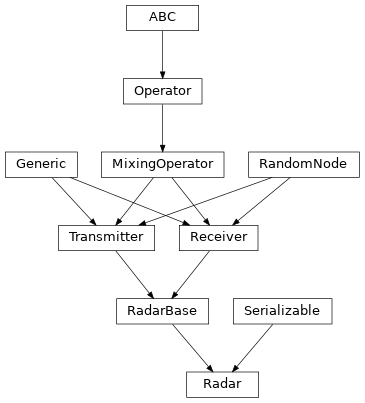Radar¶

- class Radar(waveform=None, selected_transmit_ports=None, selected_receive_ports=None, carrier_frequency=None, seed=None)[source]¶
Bases:
RadarBase[RadarTransmission,RadarReception],SerializableSignal processing pipeline of a monostatic radar sensing its environment.
The radar can be configured by assigning four composite objects to respective property attributes:
Of those, only a
RadarWaveformis mandatory. Beamformers, i.e. aTransmitBeamformerand aReceiveBeamformer, are only required when the radar is assigned to aDeviceconfigured to multipleantennas. ARadarDetectoris optional, if not configured the radar’s generatedRadarReceptionwill not contain aRadarPointCloud.When assigned to a
Device, device transmission will trigger the radar to generate aRadarTransmissionby executing the following sequence of calls:sequenceDiagram participant Device participant Radar participant RadarWaveform participant TransmitBeamformer Device ->> Radar: _transmit() Radar ->> RadarWaveform: ping() RadarWaveform -->> Radar: Signal Radar ->> TransmitBeamformer: transmit(Signal) TransmitBeamformer -->> Radar: Signal Radar -->> Device: RadarTransmissionInitially, the
pingmethod of theRadarWaveformis called to generate the model of a single-antenna radar frame. ForDevicesconfigured to multipleantennas, the configuredTransmitBeamformeris called to encode the signal for each antenna. The resulting multi-antenna frame, contained within the returnRadarTransmission, is cached at the assignedDevice.When assigned to a
Device, device reception will trigger the radar to generate aRadarReceptionby executing the following sequence of calls:sequenceDiagram participant Device participant Radar participant ReceiveBeamformer participant RadarWaveform participant RadarDetector Device ->> Radar: _receive(Signal) Radar ->> ReceiveBeamformer: probe(Signal) ReceiveBeamformer -->> Radar: line_signals loop Radar ->> RadarWaveform: estimate(line_signal) RadarWaveform -->> Radar: line_estimate end Radar ->> RadarDetector: detect(line_estimates) RadarDetector -->> Radar: RadarPointCloud Radar -->> Device: RadarReceptionInitially, the
probemethod of theReceiveBeamformeris called to generate a sequence of line signals from each direction of interest. We refer to them as line signals as they are the result of an antenna arrays beamforing towards a single direction of interest, so the signal can be though of as having propagated along a single line pointing towards the direction of interest. This step is only executed forDevicesconfigured to multipleantennas. The sequence of line signals are then indiviually processed by theestimatemethod of theRadarWaveform, resulting in a line estimate representing a range-doppler map for each direction of interest. This sequence line estimates is combined to a singleRadarCube. If aRadarDetectoris configured, thedetectmethod is called to generate aRadarPointCloudfrom theRadarCube. The resulting information is cached as aRadarReceptionat the assignedDevice.- Parameters:
waveform (RadarWaveform, optional) – Description of the waveform to be transmitted and received by this radar.
Noneif no waveform is configured.selected_transmit_ports (Sequence[int], otional) – Indices of antenna ports selected for transmission from the operated
Device'santenna array. If not specified, all available ports will be considered.selected_receive_ports (Sequence[int], optional) – Indices of antenna ports selected for reception from the operated
Device'santenna array. If not specified, all available antenna ports will be considered.carrier_frequency (float, optional) – Central frequency of the mixed signal in radio-frequency transmission band. If not specified, the operated device’s default carrier frequency will be assumed during signal processing.
seed (int, optional) – Random seed used to initialize the pseudo-random number generator.
- velocity_resolution(carrier_frequency)[source]¶
The radar’s velocity resolution in meters per second.
Denoted by \(\Delta v\) of unit \(\left[ \Delta v \right] = \frac{\mathrm{m}}{\mathrm{s}}\) in literature. Computed as :rtype:
float\[\Delta v = \frac{c_0}{f_{\mathrm{c}}} \Delta f_{\mathrm{Res}}\]querying the configured
RadarWaveform’srelative_doppler_resolutionproperty \(\Delta f_{\mathrm{Res}}\).
- property frame_duration: float¶
Duration of a single sample frame in seconds.
Denoted as \(T_{\mathrm{F}}\) of unit \(\left[ T_{\mathrm{F}} \right] = \mathrm{s}\) in literature.
- property max_range: float¶
The radar’s maximum detectable range in meters.
Denoted by \(R_{\mathrm{Max}}\) of unit \(\left[ R_{\mathrm{Max}} \right] = \mathrm{m}\) in literature. Convenience property that resolves to the configured
RadarWaveform’smax_rangeproperty. Returns \(R_{\mathrm{Max}} = 0\) if no waveform is configured.
- property power: float¶
Expected power of the transmitted signal in Watts.
Note
Applies only to the signal-carrying parts of the transmission, silent parts shuch as guard intervals should not be considered.
- property sampling_rate: float¶
The operator’s preferred sampling rate in Hz.
Denoted as \(f_{\mathrm{S}}\) of unit \(\left[ f_{\mathrm{S}} \right] = \mathrm{Hz} = \tfrac{1}{\mathrm{s}}\) in literature.
- property waveform: RadarWaveform | None¶
Description of the waveform to be transmitted and received by this radar.
Noneif no waveform is configured.During
transmit/_transmit, theRadarWaveform’sping()method is called to generate a signal to be transmitted by the radar. Duringreceive/_receive, theRadarWaveform’sestimate()method is called multiple times to generate range-doppler line estimates for each direction of interest.
- class RadarBase(selected_transmit_ports=None, selected_receive_ports=None, carrier_frequency=None, seed=None)[source]¶
Bases:
Generic[RTT,RRT],Transmitter[RTT],Receiver[RRT]Base class class for radar sensing signal processing pipelines.
- Parameters:
selected_transmit_ports (Sequence[int] | None) – Indices of antenna ports selected for transmission from the operated
Device'santenna array. If not specified, all available ports will be considered.selected_receive_ports (Sequence[int] | None) – Indices of antenna ports selected for reception from the operated
Device'santenna array. If not specified, all available antenna ports will be considered.carrier_frequency (float, optional) – Central frequency of the mixed signal in radio-frequency transmission band. If not specified, the operated device’s default carrier frequency will be assumed during signal processing.
seed (int, optional) – Random seed used to initialize the pseudo-random number generator.
- property detector: RadarDetector | None¶
Detector routine configured to generate point clouds from radar cubes.
If configured, during
_receive/receive, the detector’sdetectmethod is called to generate aRadarPointCloud. If not configured, i.e.None, the generatedRadarReception’scloudproperty will beNone.
- property receive_beamformer: ReceiveBeamformer | None¶
Beamforming applied during signal reception.
The
TransmitBeamformer’sreceivemethod is called as a subroutine ofReceiver.receive(). Configuration is required for if the assignedDevicefeatures multipleantennas.